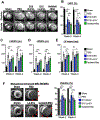Mitochondria-Rich Extracellular Vesicles From Autologous Stem Cell-Derived Cardiomyocytes Restore Energetics of Ischemic Myocardium
- PMID: 33632482
- PMCID: PMC8626617
- DOI: 10.1016/j.jacc.2020.12.060
Mitochondria-Rich Extracellular Vesicles From Autologous Stem Cell-Derived Cardiomyocytes Restore Energetics of Ischemic Myocardium
Abstract
Background: Mitochondrial dysfunction results in an imbalance between energy supply and demand in a failing heart. An innovative therapy that targets the intracellular bioenergetics directly through mitochondria transfer may be necessary.
Objectives: The purpose of this study was to establish a preclinical proof-of-concept that extracellular vesicle (EV)-mediated transfer of autologous mitochondria and their related energy source enhance cardiac function through restoration of myocardial bioenergetics.
Methods: Human-induced pluripotent stem cell-derived cardiomyocytes (iCMs) were employed. iCM-conditioned medium was ultracentrifuged to collect mitochondria-rich EVs (M-EVs). Therapeutic effects of M-EVs were investigated using in vivo murine myocardial infarction (MI) model.
Results: Electron microscopy revealed healthy-shaped mitochondria inside M-EVs. Confocal microscopy showed that M-EV-derived mitochondria were transferred into the recipient iCMs and fused with their endogenous mitochondrial networks. Treatment with 1.0 × 108/ml M-EVs significantly restored the intracellular adenosine triphosphate production and improved contractile profiles of hypoxia-injured iCMs as early as 3 h after treatment. In contrast, isolated mitochondria that contained 300× more mitochondrial proteins than 1.0 × 108/ml M-EVs showed no effect after 24 h. M-EVs contained mitochondrial biogenesis-related messenger ribonucleic acids, including proliferator-activated receptor γ coactivator-1α, which on transfer activated mitochondrial biogenesis in the recipient iCMs at 24 h after treatment. Finally, intramyocardial injection of 1.0 × 108 M-EVs demonstrated significantly improved post-MI cardiac function through restoration of bioenergetics and mitochondrial biogenesis.
Conclusions: M-EVs facilitated immediate transfer of their mitochondrial and nonmitochondrial cargos, contributing to improved intracellular energetics in vitro. Intramyocardial injection of M-EVs enhanced post-MI cardiac function in vivo. This therapy can be developed as a novel, precision therapeutic for mitochondria-related diseases including heart failure.
Keywords: bioenergetics; heart failure; human stem cells; mitochondria; myocardial infarction.
Copyright © 2021 American College of Cardiology Foundation. Published by Elsevier Inc. All rights reserved.
Conflict of interest statement
Funding Support and Author Disclosures Dr. Ikeda has received funding support through the Stanford Dean’s Postdoctoral Fellowship, Japan Heart Foundation/Bayer Yakuhin, and an American Heart Association postdoctoral fellowship. Ms. Santoso has received funding support through the Alpha Omega Alpha Carolyn B. Kuckein Student Research Fellowship. Dr. Yang has received funding support through National Institutes of Health, National Heart, Lung, and Blood Institute grants 1 K24 HL130553K and UM1 L12026; and funding support from SPARK Stanford University funding support through Stanford Cardiovascular Institute Seed Grant. All other authors have reported that they have no relationships relevant to the contents of this paper to disclose.
Figures








Comment in
-
Cardiac Mitochondrial Transplantation: The Force Awakens.J Am Coll Cardiol. 2021 Mar 2;77(8):1089-1092. doi: 10.1016/j.jacc.2021.01.017. J Am Coll Cardiol. 2021. PMID: 33632483 No abstract available.
References
-
- Yancy CW, Jessup M, Bozkurt B, et al. 2013 ACCF/AHA guideline for the management of heart failure: executive summary: a report of the American College of Cardiology Foundation/American Heart Association Task Force on practice guidelines. J Am Coll Cardiol. 2013. October 15;62(16):e147–239. - PubMed
-
- Neubauer S. The failing heart-an engine out of fuel. N Engl J Med. 2007;356:1140–1151. - PubMed
-
- Sekiguchi M. Electron microscopical observations of the myocardium in patients with idiopathic cardiomyopathy using endomyocardial biopsy. J Mol Cell Cardiol. 1974;6:111–122. - PubMed
-
- Starling RC, Hammer DF, Altschuld RA. Human myocardial ATP content and in vivo contractile function. Mol Cell Biochem. 1998;180:171–177. - PubMed
MeSH terms
Substances
Grants and funding
LinkOut - more resources
Full Text Sources
Other Literature Sources

